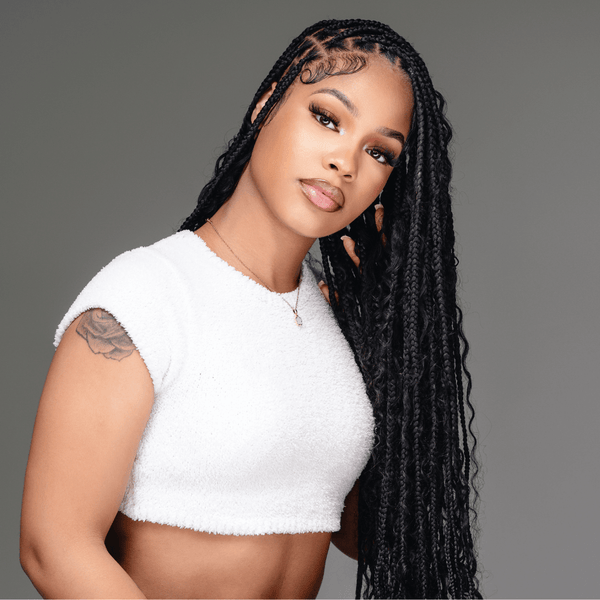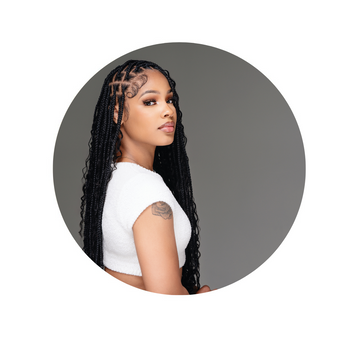How to Choose the Right Length and Texture for Braiding Hair
Selecting the right length, texture, and density of human hair extensions is essential to achieving your desired braiding style and ensuring the best possible result. Whether you’re aiming for long, flowing braids or a short, voluminous look, this guide will walk you through choosing the best options to suit your style, hair type, and personal preferences.
1. Choosing the Right Length
The length of your braiding hair impacts not only the style but also the weight and overall maintenance. Here’s how to select the ideal length for popular braiding styles:
-
Short Braids (10–16 inches): Shorter lengths are ideal for creating bob-length braids or chin-length styles that are easy to maintain and lightweight. This length works well for styles like box braids and cornrows, offering a classic, easy-to-manage look.
- Styling Tip: Short braids are versatile and look great when accessorized with beads or hair cuffs for a bold, stylish touch.
-
Medium-Length Braids (18–24 inches): Medium-length braids are perfect for shoulder-length styles that balance length and manageability. This length works well for knotless braids, Senegalese twists, and goddess braids, providing ample styling options without the weight of longer hair.
- Styling Tip: Medium-length braids can be worn up or down, allowing for a variety of styles, including half-up, half-down looks and intricate updos.
-
Long Braids (26 inches and above): Long braids create a dramatic, flowing look that adds elegance and impact. Styles like jumbo braids and bohemian braids are stunning at this length, allowing for plenty of volume and movement.
- Styling Tip: For long braids, consider lighter textures or thinner sections to avoid excessive weight, making it more comfortable for long-term wear.
Loxx Hair Insight: Remember that longer braids require more maintenance and can feel heavy, so consider your lifestyle and comfort level when choosing the length.
2. Selecting the Perfect Texture
The texture of your braiding hair determines the final look and feel of your braids, so it’s essential to choose one that complements your natural hair and desired style. Here’s a look at different textures and their styling benefits:
-
Straight Texture: Straight human hair extensions give a sleek, polished look that works well for classic styles like cornrows and micro braids. The straight texture allows for easy braiding and minimal frizz.
- Best for: Cornrows, knotless braids, and goddess braids, where a smooth, sleek finish is preferred.
- Styling Tip: Use a lightweight serum to enhance shine and keep straight braids looking polished and smooth.
-
Wavy Texture: Wavy braiding hair adds a natural, relaxed look with a bit of volume. This texture works well for styles like Senegalese twists, bohemian braids, and loose braids, providing a soft, textured finish.
- Best for: Boho-inspired styles that benefit from a bit of wave and movement, perfect for an effortless look.
- Styling Tip: Enhance the waves with a curl-enhancing spray or mousse to maintain a natural, beachy vibe.
-
Curly Texture: Curly human hair extensions create a voluminous, textured look that adds fullness to styles. Curly textures are perfect for box braids, goddess braids, and jumbo twists, adding depth and dimension.
- Best for: Styles that need extra volume and fullness, such as goddess braids and full-bodied twists.
- Styling Tip: Use a leave-in conditioner to keep curls defined and frizz-free, giving your braids a naturally soft and bouncy look.
Loxx Hair Tip: For the most natural results, choose a texture that complements your own hair, ensuring a seamless blend between natural and extension hair.
3. Density and Thickness
The density or thickness of the braiding hair influences the overall look, weight, and volume of your braids. Here’s how to choose the right density based on your style goals:
-
Light Density: Light-density extensions create a more delicate, natural look and are ideal for smaller braid sizes like micro braids or thin cornrows. This option is also beneficial for those who prefer a lighter, more comfortable style.
- Styling Tip: For a natural look, use light-density hair for styles that require a lot of small braids, as it won’t weigh down the scalp.
-
Medium Density: Medium-density hair works well for most braiding styles, offering a balanced, voluminous look without being overly heavy. It’s a versatile option for box braids, knotless braids, and twists.
- Styling Tip: Medium-density extensions are ideal for everyday wear, as they offer a fuller look without excessive weight.
-
High Density: High-density hair provides maximum volume, ideal for styles that require fullness, such as jumbo braids or goddess braids. This option creates a bold, impactful look but may feel heavier on the scalp.
- Styling Tip: For high-density braids, consider wearing styles that are secured up and off the neck, helping to alleviate some of the weight.
Stylist Insight: For those new to braiding with human hair, medium density offers a comfortable balance between fullness and manageability.
Final Thoughts
Choosing the right length, texture, and density for human hair braiding extensions can significantly impact the look, feel, and comfort of your braids. By selecting options that align with your style goals and maintenance preferences, you’ll achieve a look that not only complements your appearance but also offers long-lasting satisfaction.














